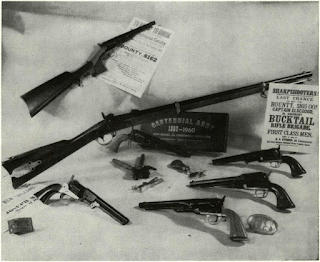Ager, Williams, Vandenberg, these have faded into history. The repeating gun most remembered from the war, and yet one which had a very confusing record of use therein, is that of Dr. Richard Jordan Gatling. I had the pleasure of witnessing how effectively Dr. Gatling had builded when I attended a meeting of the American Ordnance Association at Aberdeen the fall of 1957 . Mounted on a testing stand was a small bundle of barrels, dwarfed in seeming firepower by the huge cannon flanking it. But when the gunner pushed the button and that mighty mite whirred into action with a high-pitched snarling roar so rapidly that no individual explosions could even be sensed, I knew I had witnessed not only the world’s fastest-firing machine gun, and the world’s heaviest gun in weight of metal fired (a ton and a half in one minute), but a gun that was directly inspired by the Civil War special artillery General Butler bought from Dr. Gatling. First of Gatling’s guns was bulky wheeled carriage “c...
The complete story of Federal and Confederate small arms: design manufacture, identification, procurement, issue, employment, effectiveness, and postwar disposal. By WILLIAM B. EDWARDS

Comments
Post a Comment